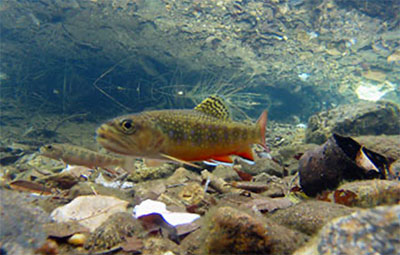
By Tom Champeau, Pisgah Chapter of Trout Unlimited
In western North Carolina, federal and state fisheries biologists are working hard to provide trout populations that support recreational fishing while protecting stocks of wild rainbow (originally from the Pacific Coast), wild brown trout (originally from Europe), and wild, native eastern brook trout. In North Carolina, brook trout are the only native species of the family Salmonidae, which globally includes salmon, trout, char, whitefish, and grayling. Brook trout are a species of char, and descended to the southern Blue Ridge during ice ages over the past million years. Over time, brook trout have genetically-diverged from ancestral populations and the Southern Appalachian Brook Trout (SABT) is considered a unique strain.
Recent studies of brook trout from across their native eastern North American range show populations within particular watersheds exhibit further genetic differences. The most up-to-date and comprehensive study was published in 2022 in the Transactions of the American Fisheries Society. This study was authored by 18 scientists from all over the country including Great Smoky Mountains National Park (GSMNP) fisheries supervisor, Matt Kulp, and North Carolina Wildlife Resources Commission (NCWRC) trout research biologist, Jake Rash. This study used the latest technology in genetic research, sampled 836 brook trout populations (over 20,000 fish), and involved dozens of laboratories and hundreds of geneticists, biostatisticians, scientists, technicians, and volunteers.
This research reveals that many populations of SABT are small and isolated in high elevation streams which makes them vulnerable to extinction from floods, drought, changing climate, in-breeding, environmental degradation, and pathogens. The map shows were populations of most conservation need are located. This work will help inform fisheries biologists to manage and conserve trout in the GSMNP, Pisgah and other national forests, and state-managed landscapes.
While this and other scientific research reveals many serious threats to the sustainability of SABT, one finding can be considered good news and rather surprising considering the landscape alterations brought on by unmanaged timber harvest during the 19th and early 20th centuries. It was in response to declines in native brook trout that wide-spread stocking of hatchery-produced rainbow, brown, and brook trout occurred.
These findings indicate that despite an extensive history of stocking, many SABT populations show little evidence of hatchery introgression (hybridization). The authors state, “the vast majority of populations retain genetic characteristics distinct from hatchery strains.” This may provide a glimmer of hope that SABT survived massive landscape alterations, and co-existed with stocked fish for over a hundred years yet still retain a high degree of genetic diversity across populations. However, within individual SABT populations, genetic diversity is often critically low, and poor genetic integrity within many populations lowers their sustainability.

Federal and state fisheries biologists are using genetic information to implement projects to restore SABT in streams in the Southeast. Restoring SABT requires the removal of existing rainbow and brown trout by repeated electrofishing or by the application of chemical toxicants. After the existing non-native trout have been eliminated from a high elevation stream (above 3,000 feet), SABT that express high genetic diversity are transferred from nearby streams. Stream sections selected for restoration flow above a barrier such as a waterfall to prevent re-introduction of non-native trout.
Do current stocking programs compromise wild trout populations?
Since the early 2000’s, NCWRC stocks only triploid trout to prevent genetic introgression (hybridization) with wild populations. Triploid fish have three sets of chromosomes which makes them sterile. Chromosomes are long strands of DNA that comprise all the genes that program the production of proteins that make life possible. Most plants and animals have two sets of chromosomes and are called diploid. A scientist at the University of Oxford named Har Swarup first produced triploid fish in 1956. Today, hatcheries across the world use various methods to create triploid fish.
How are triploid fish produced?
After fertilization of mature eggs by male sperm in a hatchery, technicians apply either pressure, heat, or cold-shock at just the right time to force eggs to retain three sets of chromosomes. The young fish produced develop just like diploid (the normal two sets of chromosomes) fish, but they cannot produce viable eggs or sperm of their own.
How many chromosomes do trout have?
While triploid fish cannot reproduce, scientists believe that many millions of years ago, Salmonids branched off through a rare genetic event called whole genome duplication (WGD). Instead of having two sets of chromosomes (diploid), a small percentage of individuals within a population were produced with four or more sets (polyploidy), and an even-numbered chromosomal complement resulted in viable eggs and sperm.
When a percentage of a population experiences WGD or polyploidy (a random event or perhaps a response to a major environmental or population stressors), a new species comes into existence in a single generation as the polyploid individuals usually cannot reproduce with diploid individuals of the original species.
This rapid mechanism of evolution is one of the drivers of the vast biodiversity on our planet. WGD is more common in plants, invertebrates, and some fish and amphibians. Polyploidy is extremely rare in mammals, and is fatal when it happens within humans. Rainbow trout have 30 pairs or 60 chromosomes, and brown and brook trout have 40 pairs or 80 total chromosomes. WGD events double chromosome number and later chromosomes merge, genes are deleted, and total number of chromosomes can be reduced. Having a large complement of genes provides salmonids the ability to adapt to many life history strategies. As Jeff Goldblum’s character said in the movie Jurassic Park: “Life always finds a way.”